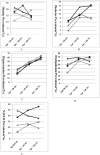Six-year changes in the prevalence of obesity and obesity-related diseases in Northeastern China from 2007 to 2013
- PMID: 28128316
- PMCID: PMC5269745
- DOI: 10.1038/srep41518
Six-year changes in the prevalence of obesity and obesity-related diseases in Northeastern China from 2007 to 2013
Abstract
Obesity and obesity-related diseases are important public health challenges. In this study, we aimed to provide updated trends in the prevalence of these conditions. We conducted two independent cross-sectional surveys of the general population aged 20-75 years in 2007 and 2013 in Jilin, China. A total of 3636 (1719 males) and 1359 (602 males) participants were enrolled in the 2007 and 2013 surveys, respectively. Obesity-related diseases were defined as type 2 diabetes, hypertension, dyslipidemia and non-alcoholic fatty liver disease (NAFLD). The age-standardized prevalence of obesity, overweight, diabetes, pre-diabetes, dyslipidemia and NAFLD increased from 2007 to 2013 from 15.82% to 19.41%, 35.85% to 41.80%, 6.37% to 9.23%, 16.77% to 23.49%., 53.46% to 65.50%, and 23.48% to 44.31% in males, respectively, and from 13.18% to 18.77%, 31.11% to 37.54%, 4.41% to 8.48%, 8.10% to 16.49%, 41.96% to 54.70%, and 17.56% to 43.06% in females, respectively. However, the prevalence of hypertension remained stable (males: 38.10% vs. 38.63% and females: 33.04% vs. 33.01% in 2007 and 2013, respectively). The prevalence of obesity and obesity-related diseases, except for hypertension, increased significantly in the general population in Northeastern China. More targeted measures should be implemented to address the serious challenges presented by these diseases.
Conflict of interest statement
The authors declare no competing financial interests.
Figures

References
-
- Shi X. D. et al.. Prevalence of obesity and associated risk factors in northeastern China. Diabet. Res. Clin. Pract. 91, 389–394 (2011). - PubMed
-
- Kelly T., Yang W., Chen C. S., Reynolds K. & He J. Global burden of obesity in 2005 and projections to 2030. Int. J. Obes. (Lond.). 32, 1431–1437 (2008). - PubMed
-
- Dixon J. B. The effect of obesity on health outcomes. Mol. Cell. Endocrinol. 316, 104–108 (2010). - PubMed
Publication types
MeSH terms
LinkOut - more resources
Full Text Sources
Other Literature Sources
Medical

